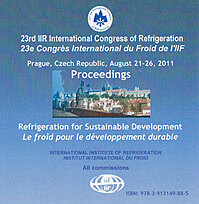
Document IIF
Étude théorique et expérimentale d'un système de ventilation par déplacement doté d'un système de ventilation personnalisé : économies d'énergie et confort thermique.
Theoretical and experimental study of displacement ventilation system assisted by personalized ventilation: energy savings and thermal comfort.
Numéro : pap. ID: 133
Auteurs : MAKHOUL A., GHALI K., GHADDAR N.
Résumé
This study emphasizes the effect of the integrated air conditioning system composed of Displacement Ventilation (DV) and Personalized Ventilation (PV) modules on the segmental and overall comfort of the human body during transient load variations and on the associated energy saving potential of the combined system. A transient DV model is coupled with a human Bioheat model to predict the temperature distribution around the human body and to assess the segmental and the induced overall thermal comfort. The results from the experiments and the simulations agreed well in predicting ambient air temperature outside the thermal plumes. The recirculated air DV system aided by the personalized ventilator is able to save 57% to 67% of energy over nineteen hours of daily operation when compared to a standalone 100% fresh air DV system while providing an acceptable comfort level.
Documents disponibles
Format PDF
Pages : 8 p.
Disponible
Prix public
20 €
Prix membre*
Gratuit
* meilleur tarif applicable selon le type d'adhésion (voir le détail des avantages des adhésions individuelles et collectives)
Détails
- Titre original : Theoretical and experimental study of displacement ventilation system assisted by personalized ventilation: energy savings and thermal comfort.
- Identifiant de la fiche : 30001580
- Langues : Anglais
- Source : Proceedings of the 23rd IIR International Congress of Refrigeration: Prague, Czech Republic, August 21-26, 2011. Overarching theme: Refrigeration for Sustainable Development.
- Date d'édition : 21/08/2011
Liens
Voir d'autres communications du même compte rendu (569)
Voir le compte rendu de la conférence
-
Human response to ductless personalized ventila...
- Auteurs : DALEWSKI M., BIVOLAROVA M., FILLON M., et al.
- Date : 16/06/2013
- Langues : Anglais
- Source : Clima 2013. 11th REHVA World Congress and 8th International Conference on Indoor Air Quality, Ventilation and Energy Conservation in Buildings.
- Formats : PDF
Voir la fiche
-
Thermal comfort and productivity for the future...
- Auteurs : TANABE S. I.
- Date : 16/08/2015
- Langues : Anglais
- Source : Proceedings of the 24th IIR International Congress of Refrigeration: Yokohama, Japan, August 16-22, 2015.
- Formats : PDF
Voir la fiche
-
Performance of ductless personalized ventilatio...
- Auteurs : DALEWSKI M., KHALIFA H. E., MELIKOV A. K.
- Date : 16/06/2013
- Langues : Anglais
- Source : Clima 2013. 11th REHVA World Congress and 8th International Conference on Indoor Air Quality, Ventilation and Energy Conservation in Buildings.
- Formats : PDF
Voir la fiche
-
Numerical study of the effect of air terminal l...
- Auteurs : YAO T., LIN Z.
- Date : 14/07/2014
- Langues : Anglais
- Source : 2014 Purdue Conferences. 3rd International High Performance Buildings Conference at Purdue.
- Formats : PDF
Voir la fiche
-
Environmental index for real-time feedback on b...
- Auteurs : HUTZEL W., LIU H., KIM J. H.
- Date : 24/05/2021
- Langues : Anglais
- Source : 2021 Purdue Conferences. 6th International High Performance Buildings Conference at Purdue.
- Formats : PDF
Voir la fiche
